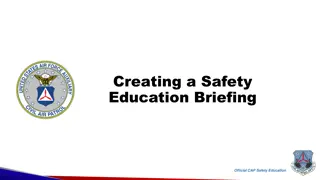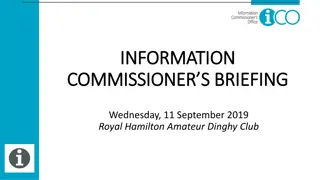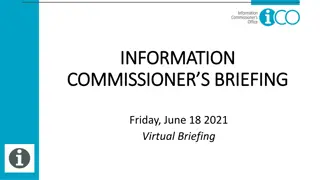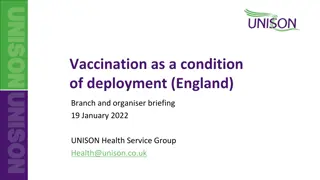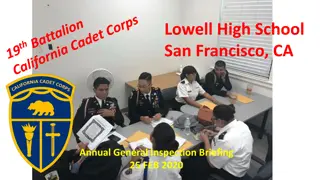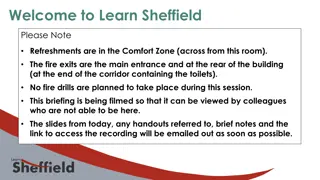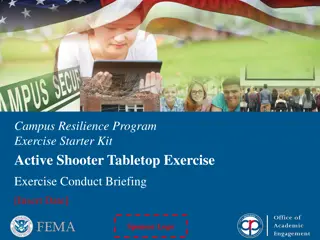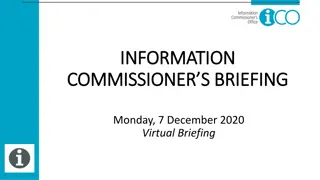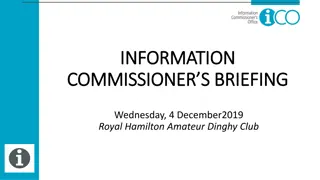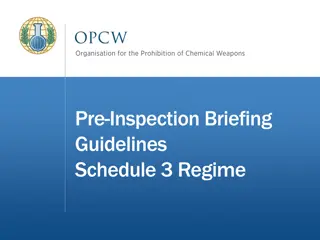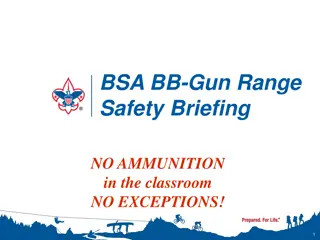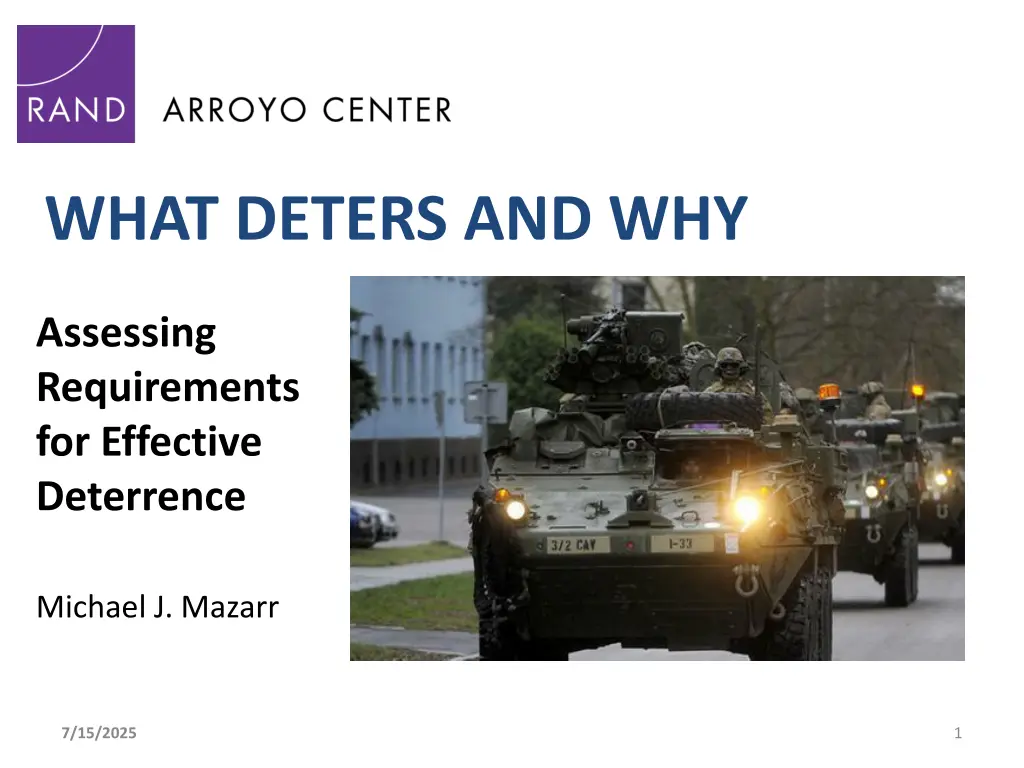
Effective Deterrence Strategies for Baltic Russia Challenges
Explore the complexities of deterrence strategies against Russian aggression in Europe, with a focus on assessing requirements for effective deterrence. The study delves into rethinking deterrence in the face of growing pressure from Russia, China, and DPRK, emphasizing the need for empirical evidence to support recommendations. By evaluating deterrence theory, conducting case studies, and analyzing post-1945 data sets, the study aims to provide insights on enhancing deterrent strength and bolstering defenses.
Download Presentation

Please find below an Image/Link to download the presentation.
The content on the website is provided AS IS for your information and personal use only. It may not be sold, licensed, or shared on other websites without obtaining consent from the author. If you encounter any issues during the download, it is possible that the publisher has removed the file from their server.
You are allowed to download the files provided on this website for personal or commercial use, subject to the condition that they are used lawfully. All files are the property of their respective owners.
The content on the website is provided AS IS for your information and personal use only. It may not be sold, licensed, or shared on other websites without obtaining consent from the author.
E N D
Presentation Transcript
WHAT DETERS AND WHY Image result for Baltic Russia deterrence Assessing Requirements for Effective Deterrence Michael J. Mazarr 7/15/2025 1
The Challenge: Rethinking Deterrence Image result for Baltics Russia Growing pressure from Russia, China, DPRK Thinking on deterrence stale, recommendations not linked to empirical evidence Focus: Conventional inter- state aggression Review existing research, conduct new case studies Image result for North Korea provocations northern limit line 7/15/2025 2
Study Question and Research Components Literature Review Conduct an analysis of fundamental deterrence theory and its potential applications to challenges of inter- state aggression, including a specific case study of deterring Russian aggression in Europe. Framework Data Set Test Case Study Test Products Review of deterrence theory and fundamentals Framework for assessing health of deterrence situation Assessment of Baltics Russia Baltic Application 7/15/2025 3
Evaluation of Framework: Quantitative Analysis and Case Studies Post-1945 Data Set Developed list of all post-1945 cases of extended & central deterrence (41 cases) Code each case with 6 or 7 variables drawn from categories in list Assess broad results, trends, correlations (no regression analysis) Case Study Tests Apply framework to 4 major case studies (Iraq 1990, West Berlin in Cold War, Georgia 2008, Nordic region in Cold War) Validate, adjust variables Russia-Baltics Application Russian views of deterrence Assessment of deterrent strength Recommendations for bolstering 7/15/2025 Do not distribute; work in progress 4
Defining Deterrence and Dissuasion Military threats, usually to prevent or discourage a state from undertaking military aggression Military and non-military threats to prevent or discourage a state from taking unwanted actions Threats and inducements to reduce the perceived need for and prospects for success in an unwanted action Image result for NATO Council Image result for U.S.-Russia diplomacy Image result for U.S. tanks in Europe Narrowest Concept Broadest Concept Rationale for the broader approach: Decisions for war are about far more than vulnerabilities or opportunities Narrow concept will not provide decision makers with effective framework Threats alone provoke as often as they deter Puts focus on aggressor perceptions Proposed study definition: The use of military or non- military deployments, threats and assurances to avoid the recourse to aggression by the target state 7/15/2025 Do not distribute; work in progress 5
Key Variables Governing Success of Deterrence Category Variable How Motivated Is the Potential Aggressor? 1. General level of dissatisfaction with status quo and determination to create a new strategic situation Degree of fear that the strategic situation is about to turn against them in decisive ways 3. Level of national interest involved in specific territory of concern 4. Urgent sense of desperation, need to act 2. Is the Defender Clear and Explicit Regarding What it Sought to Prevent and What Actions It Would Take in Response? 1. Precision and consistency in the type of aggression the United States seeks to prevent Clarity and consistency in the actions that will be taken in the event of aggression Forceful communication of these messages to outside audiences, especially potential aggressor(s) 4. Timely response to warning with clarification of interests, threats 2. 3. Did the Aggressor View the Defender s Threats as Credible and Intimidating? 1. Actual and perceived strength of the local military capability to deny the presumed objectives of the aggression Degree of automaticity of U.S. response, including escalation to larger conflict Degree of actual and perceived credibility of political commitment to fulfill deterrent threats 4. Degree of national interests engaged in state to be protected 2. 3. 6
Fundamental Deterrence Relationship A dialogue between a clear and credible threat and the intensity of an aggressor s perceived need to act Perception of strategic situation Sense of urgency, need to act Interests at stake Motivation of Aggressor Clarity and Credibility of Deterrent Message Clarity and consistency of messaging Interests at stake Local balance of forces Importance of firm-but-flexible stance that rules out opportunistic aggression while finding ways to address potential aggressor s vital interests, needs to avoid fear-based aggression 7/15/2025 7
Quantitative Evaluation Analysis of 41 post-1945 cases where the United States used either military or economic signals or threats to try to deter an armed attack on itself or the territory of a target state allies or non-allies. Success equates to no attack, but identifying success cases is complicated by aggressor motivations: If they never intended to attack, deterrence didn t succeed. How Motivated Was the Aggressor? How Clear Was the U.S.? What Degree of U.S. Interests? Did the Adversary Believe U.S. Would Respond? What Was the Local Balance of Forces? Cases of Successful Deterrence High 10 21 21 Yes 17 U.S. / allied advantage 9 Medium 11 4 5 Uncertain 9 Ambiguous 13 Low 5 1 0 No 0 Adversary advantage 4 Cases of Failed Deterrence High 9 0 3 Yes 4 U.S. / allied advantage 0 Medium 2 6 6 Uncertain 6 Ambiguous 8 Low 0 5 2 No 1 Adversary advantage 3 7/15/2025 Do not distribute; work in progress 8
Critical Emergent Relationships and General Lessons: Aggressor motivation is the essential starting point of failed deterrence Clarity and consistency of deterrent message are surest route to effective deterrence Degree of interests at stake speaks for itself and has important messaging effect A favorable local military balance is associated with success but not necessary to it, and not as important as other variables How Motivated Was the Aggressor? How Clear Was the U.S.? What Degree of U.S. Interests? Did the Adversary Believe U.S. Would Respond? What Was the Local Balance of Forces? Cases of Successful Deterrence Strong interests are critical High 10 21 21 Yes 17 U.S. / allied advantage 9 81% 81% 38% Medium 11 4 5 Uncertain 9 Ambiguous 13 Aggressor motives are decisive 65% Low 5 1 0 No 0 Adversary advantage 4 Clear U.S. commitments succeed Cases of Failed Deterrence High 9 0 3 Yes 4 U.S. / allied advantage 0 82% 0% Medium 2 6 6 Uncertain 6 Ambiguous Clear U.S. local advantage deters but deterrence succeeds without it 8 100% 73% Low 0 5 2 No 1 Adversary advantage 3 7/15/2025 9
Interim Conclusions: General Insights It s all about aggressor perceptions: Aim is not to create an objective situation, but to shape beliefs in the minds of the potential aggressor Aggression often normative rather than rationalistic calculation Motivations very complex, encompass many variables, military and non-military Road to war decision often messy, indirect, emergent rather than binary choice Opportunism less common than desperation, perceived loss Clarity, consistency of messaging absolutely essential; half-way commitments to allies risk being misperceived The importance of the principle of firm but flexible : Leaving an adversary no way out doesn t sustain deterrence No recorded cases of deterrence failure when risk of nuclear escalation was in the forefront of the crisis Local force objective should be to make it messy enough to deprive easy, quick, isolated win; challenge is how to measure this threshold Deterring aggressive ally and opposing major power at the same time is extremely difficult 7/15/2025 10
Status of Deterrence: Baltics Category Variable 1. General level of dissatisfaction with status quo and determination to create a new strategic situation How Motivated Is the Potential Aggressor? 2. Degree of fear that the strategic situation is about to turn against them in decisive ways 3. Level of national interest involved in specific territory of concern 4. Urgent sense of desperation, need to act 1. Precision and consistency in the type of aggression the United States seeks to prevent Is the Defender Clear and Explicit Regarding What it Sought to Prevent and What Actions It Would Take in Response? 2. Clarity and consistency in the actions that will be taken in the event of aggression 3. Forceful communication of messages to outside audiences, esp. aggressor(s) 4. Timely response to warning with clarification of interests, threats 1. Actual and perceived strength of the local military capability to deny the presumed objectives of the aggression Did the Aggressor View the Defender s Threats as Credible and Intimidating? 2. Degree of automaticity of U.S. response, including escalation 3. Actual and perceived credibility of political commitment to fulfill threats 4. Degree of national interests engaged in allied or partner state to be protected by deterrent threats 11
Summary: Status of Deterrence in Baltics Majority of deterrent variables are healthy Especially strong in two priority areas highlighted by analysis Aggressor motivations and clarity of promises Current status vulnerable to sudden shifts in Russian perception of strategic situation Main area of shortfall is balance of local capabilities But in addressing that, NATO must be careful not to over-correct and worsen Russian threat perceptions Multiple avenues available to reinforce deterrence Major constraint: Very difficult to take new steps to address Russian security interests before Ukraine is resolved Route to improved deterrence runs through Ukraine accord 7/15/2025 12
Actions to Enhance Deterrence, Dissuasion Short-term consultations, confidence building measures with Russia (understanding constraints b/o Ukraine) Caution with deployments of most provocative systems Partial Ukraine solution allowing relaxing tensions would have major value Emphasize lack of aggressive intent, willingness to reduce tensions Continual public emphasis of U.S. commitment Reaffirmation of ongoing contingency planning Visits by senior officials, legislative branch Direct reminders to Putin and senior Russian officials Strengthen other U.S. interests in Baltics (investments) Regular exercises, train and advise missions Steps to close key U.S. Army capability gaps for war in Europe; modest additional heavy force units to Europe Steps to indicate immediate theater-wide response to local aggression (planning, ROE); deny potential for fait accompli 7/15/2025 13
7/15/2025 14


